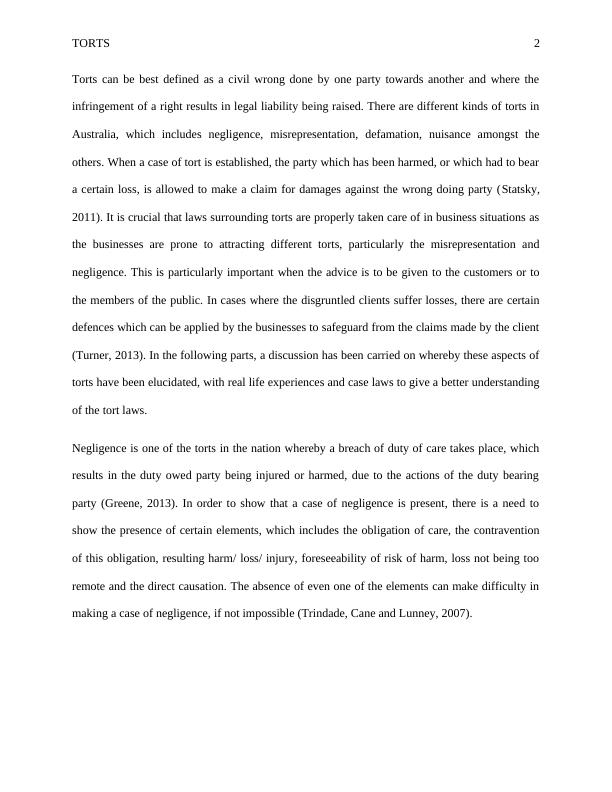Business Law BLAW204 - Tort Liability | Assignment
11 Pages3084 Words44 Views
Kent Institute Australia Pty. Ltd
Business Law (BLAW204)
Added on 2020-02-19
Business Law BLAW204 - Tort Liability | Assignment
Kent Institute Australia Pty. Ltd
Business Law (BLAW204)
Added on 2020-02-19
ShareRelated Documents

TORTS2Torts can be best defined as a civil wrong done by one party towards another and where theinfringement of a right results in legal liability being raised. There are different kinds of torts inAustralia, which includes negligence, misrepresentation, defamation, nuisance amongst theothers. When a case of tort is established, the party which has been harmed, or which had to beara certain loss, is allowed to make a claim for damages against the wrong doing party (Statsky,2011). It is crucial that laws surrounding torts are properly taken care of in business situations asthe businesses are prone to attracting different torts, particularly the misrepresentation andnegligence. This is particularly important when the advice is to be given to the customers or tothe members of the public. In cases where the disgruntled clients suffer losses, there are certaindefences which can be applied by the businesses to safeguard from the claims made by the client(Turner, 2013). In the following parts, a discussion has been carried on whereby these aspects oftorts have been elucidated, with real life experiences and case laws to give a better understandingof the tort laws. Negligence is one of the torts in the nation whereby a breach of duty of care takes place, whichresults in the duty owed party being injured or harmed, due to the actions of the duty bearingparty (Greene, 2013). In order to show that a case of negligence is present, there is a need toshow the presence of certain elements, which includes the obligation of care, the contraventionof this obligation, resulting harm/ loss/ injury, foreseeability of risk of harm, loss not being tooremote and the direct causation. The absence of even one of the elements can make difficulty inmaking a case of negligence, if not impossible (Trindade, Cane and Lunney, 2007).

TORTS3The initial step in making a case of negligence is showing that duty of care was present. For this,often a reference is made to Donoghue v Stevenson [1932] AC 562 in which the courts held thatthe manufacturer owed a duty of care towards the consumers as the relationship present betweenthem had such proximity that the acts of one had the capability of affecting another (British andIrish Legal Information Institute, 2017). The next step for establishing negligence is showing thatthis duty of care had been contravened. And it also has to be shown that the breach resulted inharm/ loss/ injury. For this purpose, it has to be shown that as a result of the duty bearing partynot doing their part, the other party was injured, to show that indeed the breach of duty tookplace and the same resulted in injuries (Emanuel and Emanuel, 2008). For this, reference needsto be made to the decision given in Paris v Stepney Borough Council [1951] AC 367. As thedefendant had failed to provide the requisite safety material to the plaintiff, as a result of which,the plaintiff was blinded completely, the defendant was held liable (Martin and Lancer, 2013). Duty of CareForseeability

TORTS4The next step in making a case of negligence is to show that the loss was substantial and not tooremote (Gibson and Fraser, 2014). Remoteness of losses resulted in no remedy being provided inOverseas Tankship (UK) Ltd v Morts Dock and Engineering Co Ltd [1961] UKPC 2 (H2O,2016). It is of utmost importance that there is foreseeability of harm being caused due to theactions of the defendant. And for this, the view of a reasonable individual has to be taken intoconsideration as per Wyong Shire Council v Shirt (1980) 146 CLR 40. The direct causation alsohas to be established where it has to be shown that the injury was a direct result of the dutybreached (Jade, 2017). Another substantial tort which the businesses often have to face is misrepresentation.Misrepresentation refers to such a situation where one party is forced to enter into the contractowing to a false statement being made by the other party. Even though misrepresentation ispredominantly covered under contract law, in some cases, it can run parallel under tort laws. Formaking a case of misrepresentation, there is a need to show that a false statement of fact hadbeen made, instead of a false statement of opinion (E-Law Resources, 2017a). In Bisset v Wilkins[1927] AC 177, the court held that a statement of opinion was made and not of fact, so a case ofmisrepresentation could not stand (E-Law Resources, 2017b). Smith v Land and House PropertyCorp (1884) 28 Ch D 7 was a case where the court held that the defendant was in a position toknow the truth or falseness of the situation and due to these reasons, a case of misrepresentationwas found to be present (E-Law Resources, 2017c).The tort of negligence and misrepresentation can easily pop up in the business situations. Forinstance, in a supermarket form of business, a number of customers come and visit thesupermarket. And it becomes a duty of care of the supermarket to provide the shoppers with asafe shopping environment. As the defendant failed to do so in Australian Safeway Stores v

End of preview
Want to access all the pages? Upload your documents or become a member.
Related Documents
Business Law in Australia with a Particular Reference to Negligence and Misrepresentation- Assessmentlg...
|10
|2768
|146
Essay on Tort Law Related to Businesslg...
|10
|3109
|46
BLAW2000 Law for Engineers | Case Studylg...
|7
|3696
|351
LAW100 Introduction To Business Lawlg...
|7
|1409
|125
The Businesses Operating in Australia (Statsky, 2011)lg...
|10
|2706
|53
LAW220 Business Organisations Law | CSUlg...
|6
|1452
|89
